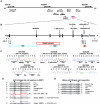Mutations in the novel mitochondrial protein REEP1 cause hereditary spastic paraplegia type 31
- PMID: 16826527
- PMCID: PMC1559498
- DOI: 10.1086/505361
Mutations in the novel mitochondrial protein REEP1 cause hereditary spastic paraplegia type 31
Abstract
Hereditary spastic paraplegia (HSP) comprises a group of clinically and genetically heterogeneous diseases that affect the upper motor neurons and their axonal projections. For the novel SPG31 locus on chromosome 2p12, we identified six different mutations in the receptor expression-enhancing protein 1 gene (REEP1). REEP1 mutations occurred in 6.5% of the patients with HSP in our sample, making it the third-most common HSP gene. We show that REEP1 is widely expressed and localizes to mitochondria, which underlines the importance of mitochondrial function in neurodegenerative disease.
Figures





Similar articles
-
REEP1 mutation spectrum and genotype/phenotype correlation in hereditary spastic paraplegia type 31.Brain. 2008 Apr;131(Pt 4):1078-86. doi: 10.1093/brain/awn026. Epub 2008 Mar 5. Brain. 2008. PMID: 18321925 Free PMC article.
-
New pedigrees and novel mutation expand the phenotype of REEP1-associated hereditary spastic paraplegia (HSP).Neurogenetics. 2009 Apr;10(2):105-10. doi: 10.1007/s10048-008-0163-z. Epub 2008 Nov 26. Neurogenetics. 2009. PMID: 19034539
-
A complete overview of REEP1: old and new insights on its role in hereditary spastic paraplegia and neurodegeneration.Rev Neurosci. 2020 May 26;31(4):351-362. doi: 10.1515/revneuro-2019-0083. Rev Neurosci. 2020. PMID: 31913854 Review.
-
Hereditary spastic paraplegia due to a novel mutation of the REEP1 gene: Case report and literature review.Medicine (Baltimore). 2017 Jan;96(3):e5911. doi: 10.1097/MD.0000000000005911. Medicine (Baltimore). 2017. PMID: 28099355 Free PMC article. Review.
-
Mitochondrial morphology and cellular distribution are altered in SPG31 patients and are linked to DRP1 hyperphosphorylation.Hum Mol Genet. 2017 Feb 15;26(4):674-685. doi: 10.1093/hmg/ddw425. Hum Mol Genet. 2017. PMID: 28007911
Cited by
-
Hereditary spastic paraplegia-linked REEP1 modulates endoplasmic reticulum/mitochondria contacts.Ann Neurol. 2015 Nov;78(5):679-96. doi: 10.1002/ana.24488. Epub 2015 Sep 16. Ann Neurol. 2015. PMID: 26201691 Free PMC article.
-
ER Morphology in the Pathogenesis of Hereditary Spastic Paraplegia.Cells. 2021 Oct 25;10(11):2870. doi: 10.3390/cells10112870. Cells. 2021. PMID: 34831093 Free PMC article. Review.
-
Genetic mutation analysis of hereditary spastic paraplegia: A retrospective study.Medicine (Baltimore). 2020 Jun 5;99(23):e20193. doi: 10.1097/MD.0000000000020193. Medicine (Baltimore). 2020. PMID: 32501971 Free PMC article.
-
REEPs are membrane shaping adapter proteins that modulate specific g protein-coupled receptor trafficking by affecting ER cargo capacity.PLoS One. 2013 Oct 2;8(10):e76366. doi: 10.1371/journal.pone.0076366. eCollection 2013. PLoS One. 2013. PMID: 24098485 Free PMC article.
-
A proteomic survey of microtubule-associated proteins in a R402H TUBA1A mutant mouse.PLoS Genet. 2020 Nov 2;16(11):e1009104. doi: 10.1371/journal.pgen.1009104. eCollection 2020 Nov. PLoS Genet. 2020. PMID: 33137126 Free PMC article.
References
Web Resources
-
- GenBank, http://www.ncbi.nlm.nih.gov/Genbank/ (for the REEP1 protein [accession number NP_075063] and REEP1 mRNA [accession number NM_022912])
-
- MicroRNA Registry, http://microrna.sanger.ac.uk/
-
- Online Mendelian Inheritance in Man (OMIM), http://www.ncbi.nlm.nih.gov/Omim/ (for KIF5A, HSP60, NIPA1, REEP1, and SPG7)
References
Publication types
MeSH terms
Substances
Associated data
- Actions
- Actions
LinkOut - more resources
Full Text Sources
Other Literature Sources
Medical
Molecular Biology Databases
Research Materials

